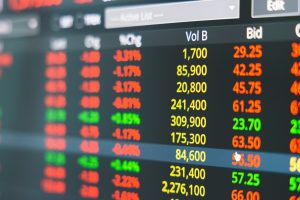
According to Barchart.com’s data for U.S. stocks hitting 52-week highs and 52-week lows, the evidence suggests there aren’t many undervalued stocks to buy right now.
In late October, Barron’s cited a Wall Street economist who said stocks are more overvalued than they have been 20 years. Since the article appeared online, the S&P 500 has gained more than 8%.
As of Dec. 6, the NYSE has 113 stocks hitting a 52-week high, 10x the number of stocks hitting a new 52-week low. The differential for the Nasdaq is much closer, with 78 hitting 52-week highs on the day versus 36 hitting a 52-week low.
The data also breaks down the 52-week highs and lows by share prices above and below $10 and those with daily volume above and below 100,000. In addition, it lists ETFs hitting 52-week highs and lows.
I’ll look at some names hitting 52-week lows to select my three undervalued stocks.
U.S. Natural Gas Fund LP (UNG)

The Barchart data shows that 12 ETFs are hitting 52-week lows. The U.S. Natural Gas Fund LP (NYSEARCA:UNG) is one of them. It is hitting a 52-week low for the 45th time over the past 52 weeks. That’s the third-highest of the 12.
UNG is an ETF that tracks the movement of natural gas prices. It has existed since April 2008. It has more than $1 billion in net assets. The ETF’s prospectus states:
“The investment objective of UNG is for the daily changes in percentage terms of its shares’ per share net asset value (‘NAV’) to reflect the daily changes in percentage terms of the spot price of natural gas delivered at the Henry Hub, Louisiana, as measured by the daily changes in the price of a specified short-term futures contract called the ‘Benchmark Futures Contract,’ plus interest earned on UNG’s collateral holdings, less UNG’s expenses.”
In mid-December 2022, UNG traded at a 52-week high of $21.67. It’s now down 77% from this high. Not surprisingly, natural gas prices are down 21% in 2023. That followed a 7.9% loss in 2022. In August 2022, the Henry Hub natural gas spot price traded as high as $9.85.
In the past decade, the spot price has closed a given year above $3 on six occasions. The last time it traded above $10 was in 2008. The lowest it’s traded to $1 over the past 25 years was in 1998, when it hit a low of $1.05.
Some expect a mild winter to push natural gas prices lower in 2024. However, if you’re a contrarian, this is a bet to make.
Yum China Holdings (YUMC)

Yum China Holdings (NYSE:YUMC) has hit a 52-week low on 13 occasions in the past year. It hit a 52-week high of $64.70 in April. It’s lost 37% since.
The company’s CEO, Joey Wat, spoke about China’s consumption slump at the recent Fortune Global Forum in Abu Dhabi. The CEO said that the average consumer there hasn’t gotten over Covid-19:
“For people outside China, the opening up happened much earlier. Nov. 14 [2022] means nothing to most people; it means the world to people in China: That’s the first day China opened up”.
YUM China was spun off from Yum Brands (NYSE:YUM) in November 2016. It is the country’s largest restaurant operator, with more than 14,000 locations in over 1,900 cities. In addition to holding the rights to KFC, Pizza Hut and Taco Bell in China, it owns the Little Sheep and Huang Ji Huang concepts outright.
At the height of its stock’s success in June 2021, it traded around $70, 180% higher than when it went public. It’s been a rollercoaster ride ever since.
The company’s price-to-sales ratio is 1.63, nearly 30% less than its five-year average. By every financial metric, it’s cheaper than it’s been since its 2016 IPO.
Yext (YEXT)

Yext (NASDAQ:YEXT) is a name I’m unfamiliar with. Its stock lost more than 20% of its value on Dec. 6, hitting a 52-week low for the sixth time over the past year. Its share price around $5.55 is 61% from its 52-week high of $14.35 that it hit in June.
The online reputation and search platform reported Q3 2024 results on Dec. 5. Revenue was $101.2 million, 2% higher than a year ago, but $1 million below the analyst estimate for the quarter. In addition, the company projected Q4 2024 revenue of $100.3 million, nearly $2 million shy of the consensus.
Weirdly, it delivered non-GAAP earnings per share of nine cents in the third quarter, two cents better than the consensus, yet investors could only focus on the slight revenue miss.
Go figure?
What I find attractive about its business are the gross margins. In Q3 2024, they were 78.2%, 400 basis points higher than a year ago.
So, for all of 2024, it expects revenue of at least $402.7 million with adjusted EBITDA of $51.7 million, 12.8% of revenue.
I look at its business and see a glass that is half full. In Q3 2024, its pre-tax GAAP loss was $102,000, down from $11.9 million, a significant reduction in its losses. In a couple more quarters, it ought to be GAAP profitable.
This is an interesting buy for aggressive investors only.
On the date of publication, Will Ashworth did not have (either directly or indirectly) any positions in the securities mentioned in this article. The opinions expressed in this article are those of the writer, subject to the InvestorPlace.com Publishing Guidelines.





